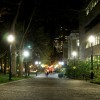Chief of Campus Public Safety Phil Zerzan first noticed it on his way to work one fall term morning—Portland State’s campus was brighter.
“I get to campus when it’s still dark and I can see how, compared to the areas around it, the PSU campus is much more lit up,” Zerzan said.
These changes are the work of PSU’s electricians, who emphasized the benefits of replacing old light fixtures with LED lights, said Dan Zalkow, PSU’s executive director of Planning, Construction and Real Estate.
“There are many benefits in replacing these outdated light fixtures,” he said, “and it’s really impressive the amount of work the electrical staff has done.”
According to Zalkow, over the last two years there’s been a strong emphasis on replacing old light fixtures with LED lights for three reasons: LED lights are brighter than those they replaced, so they create a safer environment; they are more energy efficient, decreasing the university’s utility costs; and they are more environmentally friendly, reducing the university’s carbon footprint.
Since the changes were implemented a year ago, university electricians have replaced 1,200 exterior lights, mainly in the major parking structures, some stairwells and in the Park Blocks.
Ryan Roberts, lead electrician in the Facilities and Property Management office, said the updates are all about student safety.
“[These light fixtures] produce 2 1/2 times the amount of light, using less wattage than the old lights,” he said. “These lights have an occupancy sensor and come up to full bright within three seconds. They’re bright for five minutes, and then they ramp down to 50 percent power within five minutes, yet only consume half the wattage as the old lights.”
“I’ve heard my officers talking about it,” Zerzan said. “In the last few months they’ve noticed a campus-wide significant improvement in lighting.”
According to Zalkow, Roberts worked with Electrical Supervisor Mick Nelson to lead the effort to make these changes happen, adding that incredible amounts of research went into selecting the new fixtures that were purchased.
“These guys are absolute experts,” Zalkow said.
In researching which lighting fixtures would best suit the university’s needs, Roberts looked at several factors.
“I picked the fixture we went with based on energy output, price and what was best suited for parking structures. The fixture we went with, compared to others, was the best, hands down,” he said. “These new fixtures will save the university about $28,000 a year in power costs.”
Roberts worked with the Leadership and Facilities department as well as Transportation and Parking Services and began looking for funds, then made a presentation to upper management, Zalkow said.
“The university saw how much sense these improvements made and ultimately everyone was convinced this was a great use of PSU’s financial resources,” he said. “They were impressed at how compelling the case was that Roberts and Nelson made at the presentation.”
Roberts was able to involve Energy Trust of Oregon, a company that provides custom incentives to complete projects like updating lighting fixtures.
“It will work out to where they pay approximately half the cost of these updates,” he said. “Transportation and Parking Services will be receiving about $65,000 from Energy Trust.”
The manufacturer Roberts picked is based out of Garden City, Idaho, near Boise, and Roberts said it was a choice that proved beneficial.
“I was able to develop a personal relationship with the manufacturer,” he said. “I knew what I wanted and needed in the fixture and I was able to negotiate directly with them on the price, which ended up saving about $85,000.”
Through these efforts, all the lights in Parking Structures One, Two and Three, and the Fourth Avenue Building parking lot have been replaced. They’re now working on the lights in the Park Blocks and have updated between 10 and 15 of those light fixtures already.
“For the lights in the Park Blocks, the whole globe is diffused well and designed to not have light pollution,” Roberts said. “I was also able to have the manufacturer match the paint around the top of the globe to the paint on the base of the fixtures, so they look really classy.” Light pollution is a term for excessive or misdirected light.
The next step will be to update the lights inside university buildings.
“We’re updating the lights in the study areas on every floor in Cramer Hall,” Roberts said.
“I’ve done a lot of work to make this project awesome,” he added, smiling, “but it really is all about student safety, and we’re trying to be proactive [about it].”

